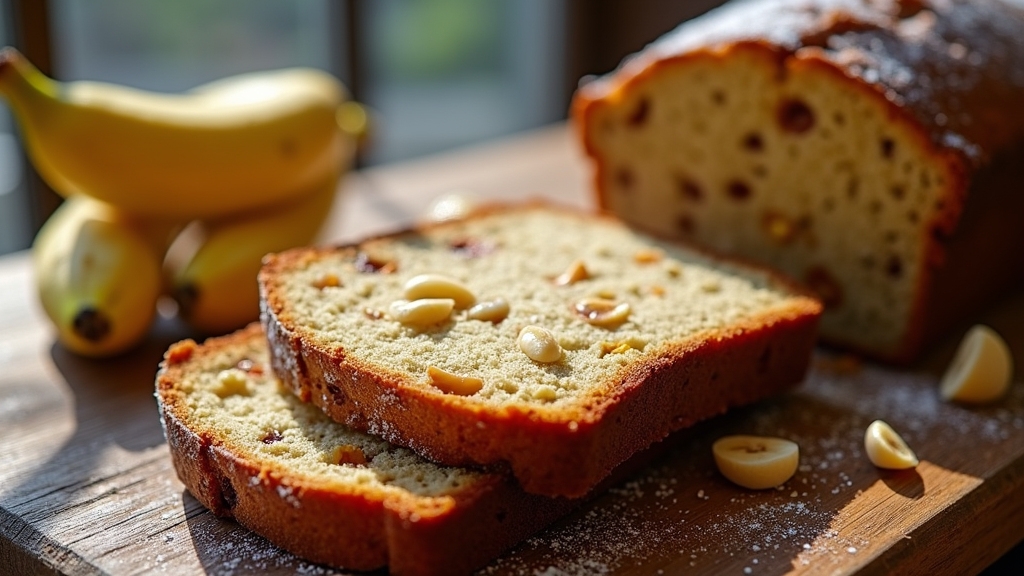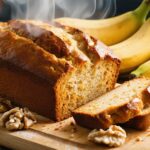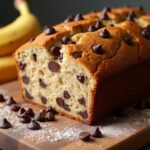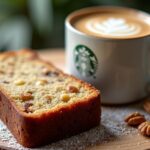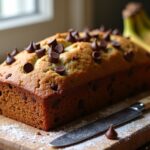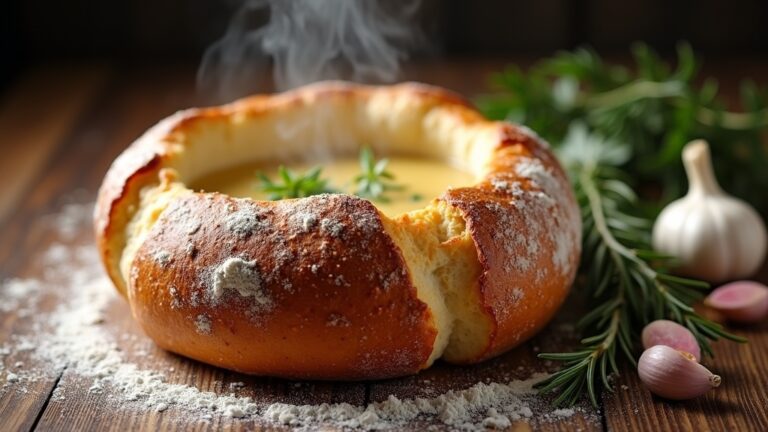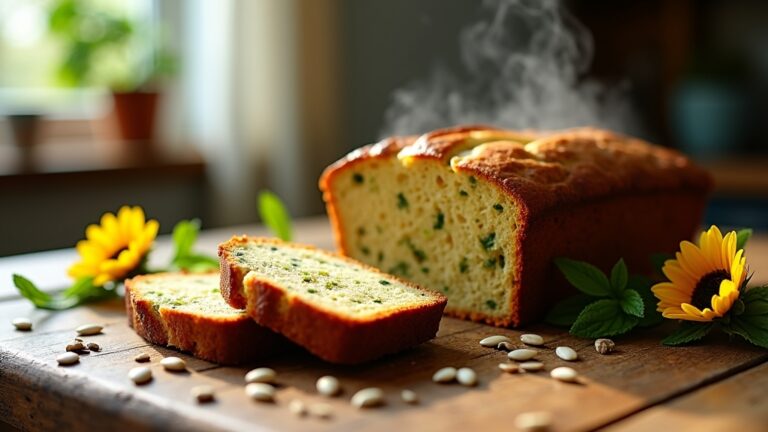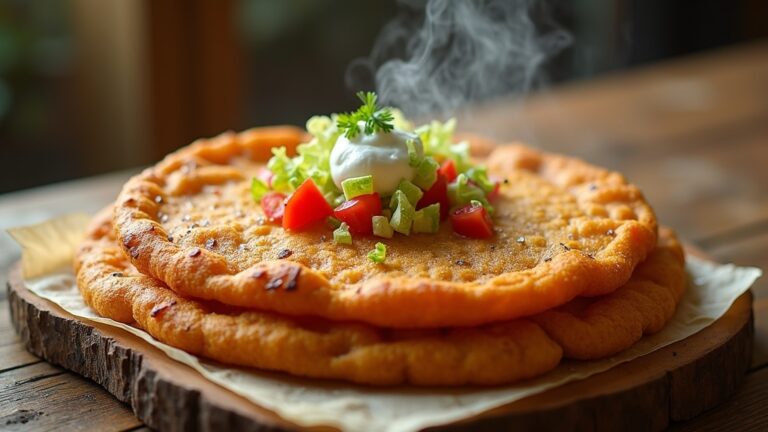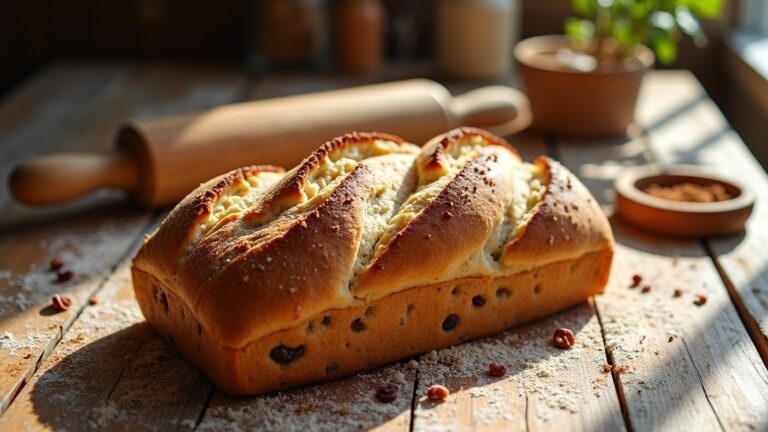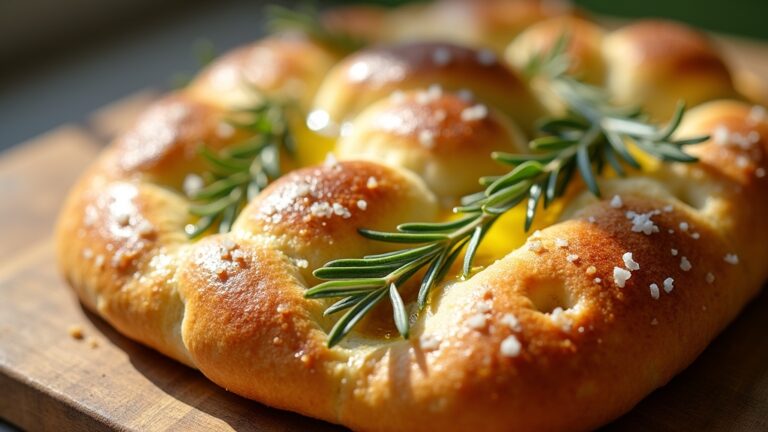Hawaiian Banana Bread Recipe
For a tropical twist on traditional banana bread, I always go for a Hawaiian version that’s bursting with flavors of pineapple, coconut, and macadamia nuts. Start by whisking together your wet ingredients, then sift in the dry ones to create a smooth batter, ensuring your measurements are precise. I usually pour all into a greased loaf pan, baking it to a golden perfection. Ready to amplify your culinary skills? There’s exciting variety waiting to be explored in the nuances of this delightful recipe.
Contents
History
While exploring the origins of Hawaiian banana bread, it’s fascinating to uncover how this delightful variant evolved from traditional recipes brought by immigrants. The cultural significance of this bread is deeply rooted in the blending of various culinary traditions. Immigrants from Portugal, the Philippines, and Japan introduced their unique baking styles, which merged with local Hawaiian ingredients, particularly the apple bananas, known for their sweeter, richer flavors. This synthesis resulted in distinct regional variations; for instance, some versions incorporate coconut or pineapple for added tropical notes. Through precise culinary adaptation, Hawaiian banana bread emerged not merely as a treat but as a vibrant expression of Hawaii’s diverse cultural tapestry, each loaf a reflection of the islands’ rich, shared culinary heritage.
Recipe
Hawaiian banana bread brings a tropical twist to the traditional banana bread with the addition of pineapple, coconut, and sometimes macadamia nuts. These ingredients not only infuse the bread with a distinctively rich and fruity flavor but also add delightful texture contrasts that make each bite a little taste of the islands. Perfect for breakfast, a snack, or as a dessert, this bread can be a comforting treat or a special occasion delight.
Experience the flavors of the islands with Hawaiian banana bread, featuring pineapple, coconut, and optional macadamia nuts.
This recipe is relatively simple and includes common baking ingredients alongside the special Hawaiian additions. Whether you’re an experienced baker or trying your hand at baking for the first time, this recipe is straightforward and forgiving, making it a fun baking project with delicious results.
Ingredients:
- 2 cups all-purpose flour
- 1 teaspoon baking soda
- 1/4 teaspoon salt
- 1/2 cup unsalted butter, softened
- 3/4 cup brown sugar
- 2 large eggs, beaten
- 2 1/3 cups mashed overripe bananas (about 4-5 medium bananas)
- 1/2 cup crushed pineapple, drained
- 1/2 cup shredded coconut
- 1/2 cup chopped macadamia nuts (optional)
- 1 teaspoon vanilla extract
Instructions:
Preheat your oven to 350°F (175°C) and grease a 9×5 inch loaf pan. In a large bowl, whisk together the flour, baking soda, and salt. In another bowl, cream together the softened butter and brown sugar until light and fluffy. Add the beaten eggs and mashed bananas, mixing until well combined. Stir in the pineapple, coconut, macadamia nuts (if using), and vanilla extract. Gradually add the dry ingredients to the wet, stirring just until incorporated. Pour the batter into the prepared loaf pan and smooth the top with a spatula.
Extra Tips:
For the best flavor and texture, make sure your bananas are very ripe — the more speckled, the better. Overripe bananas contribute to the bread’s moistness and sweetness. Draining the pineapple thoroughly is essential to prevent the bread from becoming too soggy. If you prefer a crunchier texture, you can toast the coconut and macadamia nuts slightly before adding them to the batter. Letting the bread cool completely in the pan on a wire rack before slicing will help you achieve clean cuts without crumbling. Enjoy your Hawaiian banana bread warm or at room temperature, perhaps with a spread of cream cheese or a dollop of whipped cream for an extra indulgent treat.
Cooking Steps
Let’s get started on making this delightful Hawaiian banana bread by first gathering all necessary ingredients, ensuring everything is measured with precision. Next, I’ll whisk together the wet ingredients until they’re well emulsified, setting the stage for a moist, tender loaf. Then, I’ll sift the dry ingredients to promote an even, fine texture before combining them with the mashed bananas and transferring the batter into a greased loaf pan for baking.
Step 1. Gather Ingredients
Before you begin crafting your Hawaiian banana bread, it’s essential to assemble all the necessary ingredients. Ingredient selection plays a pivotal role in enhancing the culinary experience. Start with 200 grams of all-purpose flour, sifted for a fine texture. Choose ripe bananas, about 450 grams, as they offer a natural sweetness and moisture vital for the bread’s consistency. Incorporate 150 grams of granulated sugar and a pinch of salt to balance the flavors. For a tropical twist, select 100 grams of crushed pineapple, drained to prevent excess liquid. To infuse local flair, add 50 grams of macadamia nuts, roughly chopped. These components not only contribute complex flavor variations but also create a visually appealing and aromatic final product.
Step 2. Mix Wet Ingredients Together
After you’ve gathered the ingredients, start by mashing the ripe bananas in a large mixing bowl until they’re smooth. Next, add 1/3 cup of melted unsalted butter, making sure it blends seamlessly with the banana puree. Incorporate two beaten eggs, each at room temperature, using a whisk to achieve a homogenous mixture. This is essential for texture uniformity. Precisely measure and pour in 1/2 cup of coconut milk and 1 teaspoon of vanilla extract, stirring continuously to maintain a consistent viscosity.
Utilize advanced mixing techniques like folding to gently integrate these liquids without deflating the mixture. Paying close attention to ingredient proportions is key here; a balanced ratio guarantees the wet mixture supports the structure of the bread while enhancing moistness and flavor.
Step 3. Combine Dry Ingredients
I’ll now shift focus to combining the dry ingredients important for our Hawaiian Banana Bread. Begin by employing dry measurement techniques to guarantee precision. Measure 2 cups of all-purpose flour by spooning it into your measuring cup and leveling it off with a knife; this avoids excess, maintaining the essential ingredient ratio. Add 1 teaspoon of baking soda and 1/2 teaspoon of salt, sifting together to integrate and aerate, which promotes a lighter, more consistent texture.
Integrating these ingredients uniformly is significant as it impacts the structure and flavor profile of the bread. By meticulously balancing these ratios, we set the stage for a perfectly moist and tender crumb, vital for capturing that authentic Hawaiian essence.
Step 4. Add Bananas to Mixture
Now, let’s add the bananas, which are the heart of this Hawaiian Banana Bread. You’ll want to incorporate exactly three ripe bananas. First, peel them and use a fork to mash until the consistency is uniformly creamy. This process is vital as it directly influences the bread’s moistness and guarantees the rich, sweet flavor characteristic of the bananas permeates every slice.
Meticulously fold the mashed bananas into your existing mixture. This gentle integration preserves the airiness of the batter while allowing the banana benefits, like enhanced moisture and natural sweetness, to distribute evenly. This isn’t just mixing; it’s an artful blending that promises flavor enhancement, transforming the ordinary into an extraordinary tropical delight with each bite.
Step 5. Pour Into Loaf Pan
Preheat your oven to 350 degrees Fahrenheit before greasing a 9×5 inch loaf pan with butter or non-stick spray. Now, carefully pour your banana bread batter into the prepared pan. It’s essential to understand the impact of different loaf pan types on your baking results. For instance, glass pans tend to retain more heat than metal, potentially speeding up the baking process. To guarantee even baking, tap the pan gently on your counter to remove any air bubbles—a key technique in achieving a uniform texture. Smooth the top with a spatula to create an aesthetically pleasing surface that will rise evenly. This step not only preps for ideal heat distribution but also sets the stage for a visually stunning loaf.
Nutritional Guide
Understanding the nutritional content of Hawaiian banana bread is essential for those monitoring their dietary intake. Here’s a detailed breakdown to enhance your understanding of its impact on your health.
| Nutrient | Per Serving |
|---|---|
| Calories | 210 kcal |
| Carbohydrates | 32g |
| Proteins | 3g |
Exploring the health benefits, incorporating ingredient substitutions such as almond flour or erythritol can greatly alter these figures, promoting a healthier profile. Almond flour increases the protein content, while erythritol reduces the calorie count, making it suitable for those on low-sugar diets. This innovation not only caters to health-conscious individuals but also guarantees that the bread remains a delightful treat.
Final Thoughts
Reflecting on the nutritional guide provided, it’s clear that Hawaiian banana bread can be adapted to fit various dietary needs. By experimenting with delicious variations, you can tailor this classic treat to be more health-conscious or indulgent according to your preference. Utilizing precise measurements, consider substituting granulated sugar with coconut sugar or adjusting the wheat flour ratio with almond flour for a gluten-sensitive option.
In terms of baking tips, always make sure your bananas are adequately ripe to optimize moisture and natural sweetness—this is essential for achieving the desired texture and depth of flavor. Remember, the art of baking is as much about precision in ingredients as it is about the artistic presentation. Here’s to your next innovative creation!
Frequently Asked Questions
Can I Use Frozen Bananas for Hawaiian Banana Bread?
Yes, you can use frozen bananas. Thaw them first, ensuring minimal moisture loss for ideal flavor concentration. This method enhances the bread’s texture, introducing a revolutionary twist to traditional recipes.
What Are Good Substitutes for Macadamia Nuts in This Recipe?
If you’re swapping out macadamia nuts, try using equal parts walnuts for their rich texture, or coconut flakes for a tropical twist. Both alternatives will maintain the artistic integrity and innovative flair of your dish.
How Do I Store Leftover Hawaiian Banana Bread?
To keep your banana bread fresh, wrap it tightly in cling film or store it in an airtight container. These storing tips help maintain moisture and flavor for up to a week.
Can Hawaiian Banana Bread Be Made Gluten-Free?
You can make it gluten-free by substituting traditional flour with gluten-free flours like almond or coconut. Guarantee precise measurements and consider adding xanthan gum for texture. Experiment with artistic presentation for flair!
Is There a Vegan Version of Hawaiian Banana Bread?
Yes, you can craft a vegan version by substituting eggs with flaxseed mix and butter with coconut oil. Experiment with banana alternatives like applesauce for an innovative twist, maintaining precise measurements for consistency.
Conclusion
As I wrap up this tropical treat tutorial, remember: baking banana bread brings both bliss and balance to your baking repertoire. Precisely measure each ingredient to guarantee perfection, and present your loaf with a flourish, perhaps garnished with a sprinkle of shredded coconut or a drizzle of dark chocolate. Whether you’re a seasoned baker or a curious cook, this Hawaiian banana bread recipe promises to please your palate and add a dash of delight to your dessert dishes. Enjoy every bite!
